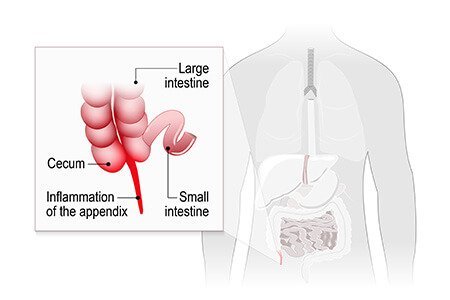Lets explore the appendicitis types and its treatment.
What is appendicitis?
Your appendix can develop appendicitis when it gets inflamed, most frequently as a result of a blockage. It could be acute or ongoing. The most typical cause of stomach discomfort requiring surgery in the US is appendicitis. It affects up to 9% of Americans at some time in their lives.

A little pouch connected to the intestine, the appendix. Your lower right abdomen is where it’s positioned. Bacteria can grow inside your appendix when it becomes obstructed. Pus and edoema may grow as a result, putting pressure on your abdomen that hurts. Blood flow can also be blocked by appendicitis.
Your appendix may rupture if appendicitis is not treated. Bacteria could enter your abdominal cavity as a result, which could be dangerous and occasionally fatal.
Types of appendicitis
Acute appendicitis
A severe and sudden bout of appendicitis is referred to as acute. Between the ages of 10 and 30, children and young adults are the most susceptible and affects men more often than women. Over the course of a day, pain frequently starts out mild and quickly gets worse.
It needs emergency medical attention. It can result in the rupture of your appendix if untreated. This issue has the potential to be lethal.
About 7 to 9 percent of all Americans will experience acute appendicitis in their lifetime, which is more prevalent than chronic appendicitis.
Chronic appendicitis
Less frequently than acute appendicitis, chronic appendicitis. Only 1.5% of persons who have already experienced chronic appendicitis experience it.
The symptoms of chronic appendicitis might be somewhat modest and are generally assumed to follow an episode of acute appendicitis. Over the course of weeks, months, or even years, symptoms may stop and then come back.
The diagnosis of this kind of appendicitis might be difficult. Occasionally, it doesn’t get diagnosed until it turns into acute appendicitis. Appendicitis that persists can be dangerous.
Symptoms of appendicitis
In the early stages of appendicitis, you may have light abdominal cramping that gradually spreads to your lower right abdominal quadrant. This ache frequently:
- begins abruptly
- worsens when you cough or move
- is so strong it wakes you up from sleep
- is intense and distinct from any prior stomach discomfort that you may have had
- within a few hours becomes worse
These are some other signs of appendicitis:
You might suffer gastrointestinal issues less frequently, such as:
- diarrhoea
- constipation
- the want to go to the bathroom
- inability to exhale
Avoid using laxatives or an enema if you have constipation and think you could have appendicitis. Your appendix may rupture as a result of these procedures.
If you experience any other appendicitis symptoms in addition to soreness on the right side of your abdomen, call your doctor straight once. A medical emergency can arise from appendicitis very quickly. Find out all you need to know to identify this dangerous disease.
Call your child’s doctor as soon as you see any appendicitis symptoms in your child.
Causes and risk factors
Appendicitis’ precise cause is frequently unknown. According to experts, it arises when a portion of the appendix becomes clogged or obstructed.
Your appendix may get blocked for a variety of reasons, including:
- a mass of hardened faeces
- increased lymphoid follicle size
- digestive worms
- a serious injury
- tumours
Abdominal pain can be brought on by numerous medical conditions. For information on more possible causes of pain in your lower right abdomen, go here.
Anyone can get appendicitis. However, some people can be more prone to this illness than others. Appendicitis risk factors include:
- Age. Although it can happen at any age, appendicitis most frequently affects adolescents and persons in their 20sTrusted Source.
- Sex. Males are more likely than females to develop appendicitis.
- Family background. An increased chance of having appendicitis exists in people with a family history of the condition.
How is Appendicitis Diagnosed?
Appendicitis can be difficult to diagnose. Many times, the symptoms of an illness, such as gallbladder issues, bladder or urinary tract infections, Crohn’s disease, gastritis, kidney stones, intestinal infection, and ovary issues, are vague or resemble those of other conditions.
Appendicitis can be identified using these tests:
- Checking your abdomen for any irritation
- To rule out a urinary tract infection, use a urine (pee) test.
- Rectal examination
- To determine whether your body is battling an infection, have a blood test
- A CT scan
- Ultrasound
Treatment of appendicitis
According to the NIDDK, a doctor will recommend antibiotics to anyone who has appendicitis. This can successfully treat appendicitis in some instances without the need for surgery. Nevertheless, the appendix must typically be removed by a surgeon.
Appendicitis surgery possibilities include:
- Laparoscopy: This is a precise procedure that only requires a little incision and little blood loss. As a result, there is less scarring and the recovery period is shorter than with open surgery. The following steps are involved in laparoscopic, keyhole, or minimally invasive surgery (MIS):
- Through a hollow instrument called as a cannula, the surgeon inserts a laparoscope—a very thin tube with a tiny video camera and light—into the abdomen.
- On a monitor, the surgeon can see a magnified image of the abdomen.
- Small abdominal incisions are used to remove the appendix, which is done with the aid of tiny instruments that are controlled by the surgeon’s hands.
- Open surgery: In extremely rare circumstances, a wider incision will be made to allow for thorough cleaning of the abdominal cavity. If the following occurs:
- An infection has spread after the appendix ruptured.
- The abscess was brought on by the appendix.
- patient has digestive system tumours.
- The patient is a woman who is nine months pregnant.
- The patient has undergone numerous abdominal procedures.
Therefore, the patient will get intravenous antibiotics following open surgery.
Recovery time for appendicitis
With keyhole surgery, the patient can typically return home after 24 hours. The patient may feel some constipation, soreness, and bruising over the first few days.
Additionally, there could be soreness near the shoulder’s point. The surgeon inflates the abdomen with gas while performing the procedure. This may result in phrenic nerve stimulation at the diaphragm, which brings on referred pain. The real pain cause is not present where the referred pain arises.
Painkillers sold over-the-counter (OTC) may ease postsurgical discomfort. The patient might need to stay in the hospital for up to a week if open surgery is required, or if peritonitis or another complication is present.
For three to five days following a laparoscopic procedure, one should avoid strenuous activities. After a laparotomy, they should refrain from physical exertion for 10–14 days. At each stage of rehabilitation, the doctor will provide guidance on the appropriate level of exercise. It is crucial to call the doctor if there are any infection-related symptoms.
Infection warning signs include:
- swelling and discomfort getting worse
- recurring vomiting
- a high degree
- It is too hot to touch the operation site.
- the surgical site is discharged with pus or another material
REFERENCES:
- https://www.healthline.com/health/appendicitis
- https://www.mayoclinic.org/diseases-conditions/appendicitis/symptoms-causes/syc-20369543
- https://www.medicalnewstoday.com/articles/158806
- https://my.clevelandclinic.org/health/diseases/8095-appendicitis
- https://www.webmd.com/digestive-disorders/digestive-diseases-appendicitis
For more details, kindly visit below.

